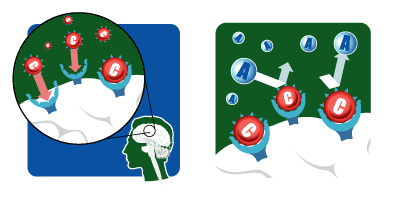Caffeine Metabolism

Have you ever thought about what is actually going on in your body when you throwback that energy drink or sip that coffee?
How is caffeine broken down and how does it affect your metabolism? How long does caffeine stay active in your system and why do people crave the stuff?
We’ll try to answer those questions and more, in the simplest terms possible, so that you can be an educated consumer when it comes to caffeine metabolism and what caffeine is actually doing to your body.
Caffeine Metabolism: From the First Sip
Caffeine easily passes through epithelial tissue so, from the first sip, caffeine is entering your bloodstream through the lining of your mouth, throat, esophagus, and stomach.
It only takes about 45 minutes for 99% of the drink’s caffeine to be absorbed through these membranes/organs.
In humans, the half-life for caffeine is anywhere from 4 to 6 hours on average, which explains why the average energy drink or coffee’s effects last about 4 to 6 hours.
Things like age, medical conditions, and drug interactions can have an effect on the rate at which caffeine is metabolized.
Note: Humans also have 3 levels of sensitivity to caffeine. This also determines how fast caffeine is metabolized and to what degree its stimulating properties are felt. Read about those here.
Caffeine in the Bloodstream
While most research on caffeine has been conducted using animals, the data has been converted to show the most likely effect on the human body due to the similarities of our digestive systems.
As soon as the caffeine enters the bloodstream the liver begins to metabolize caffeine and break down the molecule into theophylline, theobromine, and paraxanthine.
From there, these chemicals travel throughout the body where they affect various body functions.
It’s in Your Genes
Join our newsletter
Watching your caffeine intake? Get the latest brews and caffeine news.The speed at which caffeine is metabolized depends on specific genes. Research continues to discover gene variations that appear to be responsible for how long caffeine stays in the bloodstream.
People with a specific variation of the gene PDSS2 process caffeine more slowly than others. They, therefore, need less coffee for the same stimulant effects.
Caffeine in the Brain
Not all caffeine can immediately be broken down by the liver, so some free caffeine remains in general circulation. Some of which makes its way to the brain. The caffeine molecule is similar in shape to the adenosine molecule which is a neurotransmitter. Since these two molecules are so similar, caffeine molecules are able to bind to the brain’s adenosine receptors and therefore block adenosine from binding and doing its job.

Adenosine plays a role in the sleep-wake cycle. When adenosine binds to enough receptors, it signals the brain that it is time for rest or sleep. Caffeine doesn’t replace the person’s need for sleep but masks tiredness since adenosine can no longer do what it is intended to do.
This process also interferes with the dopamine system in the brain. Dopamine, which is the “feel-good” neurotransmitter becomes more plentiful when adenosine is blocked by caffeine and this causes increased feelings of well-being and happiness. Furthermore, elevated levels of adenosine in the blood cause the adrenal glands to release adrenaline. This stimulating hormone further adds to the feelings of alertness and energy.
Here’s a great TEDEd video that explains what happens in the brain.
Caffeine’s Effects on the Body
Besides affecting the brain, caffeine and its metabolites have various other effects on the human body.
Theophylline relaxes smooth muscles, which is beneficial to those with asthma and is the reason why after drinking caffeine a person often feels the need to use the bathroom since theophylline is relaxing the smooth muscles of the colon.
Theobromine increases the amount of oxygen and nutrients that can be used by the brain and muscles.
Caffeine causes an initial contracting of artery walls (vasoconstrictor) but then the metabolite theophylline relaxes this smooth muscle which has an overall vasodilator effect on the blood vessels. In other words, it opens blood vessels to allow for greater blood flow. src.
There have been many other researched effects of caffeine covered by Caffeine Informer, but the above represents the most researched and common.
Caffeine’s Exit from the Body
The remaining caffeine metabolites are then filtered by the kidneys and they exit the body with the urine.
Caffeine has been shown to have a diuretic effect on the body, which basically causes the body to release more water in the urine. However, new research suggests that this is only in people who have not built up a tolerance to the caffeine molecule.
When most of the caffeine has exited the body or has been used by the various cells of the body, the person can experience a “crash” that is caused by the elevated levels of adenosine which are now able to attach themselves to the brain’s adenosine receptors. This also causes dopamine to be repressed. All of this causes feelings of tiredness, fatigue, and even mild depression.
Prolonged use of caffeine and then quitting also causes withdrawal symptoms due to the addictive nature of caffeine.
- Take the Overcoming Caffeine Withdrawal course.

- Use Wean Caffeine (something we helped get to market). It helps avoid the painful withdrawal symptoms that occur when quitting caffeine.
The takeaway is that humans metabolize caffeine in a step-by-step process, but, this process occurs at different rates depending on the amount of caffeine consumed and the genetic makeup of the individual.
References
- Smithsonian.com
- Biology Online
- Tassaneeyakul, W., Birkett, D. J., McManus, M. E., Tassaneeyakul, W., Veronese, M. E., Andersson, T., ... & Miners, J. O. (1994). Caffeine metabolism by human hepatic cytochromes P450: contributions of 1A2, 2E1 and 3A isoforms. Biochemical pharmacology, 47(10), 1767-1776. Link
- Grant, D. M., Tang, B. K., & Kalow, W. (1983). Variability in caffeine metabolism. Clinical Pharmacology & Therapeutics, 33(5), 591-602. link
- Echeverri, D., Montes, F. R., Cabrera, M., Galán, A., & Prieto, A. (2010). Caffeine's vascular mechanisms of action. International journal of vascular medicine, 2010. study link


